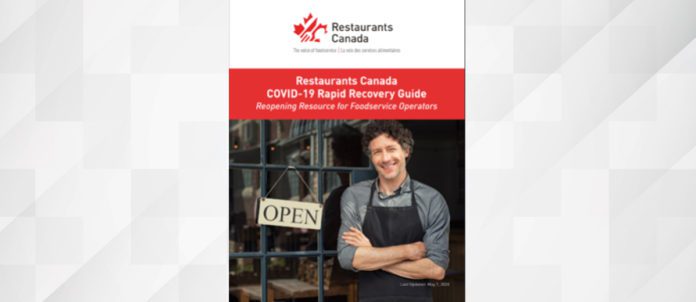HALIFAX — Restaurants Canada and the Restaurant Association of Nova Scotia (RANS) released an updated Restaurant COVID-19 Recovery Guide for Nova Scotia Foodservice Operators to assist them in developing a cohesive operating plan prior to re-opening as mandated by the Nova Scotia government. The guide includes a list of recommended practices that can be implemented in the following areas: food safety; cleaning and sanitation; health and personal hygiene; physical distancing; marketing; and financial planning.
First, many restaurant operators have enhanced their food-safety protocols since the onset of COVID-19. The most apparent protocol requires food handlers to obtain a Food Safety Certification that includes COVID-19 awareness to minimize the risk of an outbreak. Other food-safety guidelines include: ensuring compliance with Nova Scotia Food Retail and Food Service Code; using proper utensils to reduce direct hand contact with prepared food; and ensuring suppliers adhere to provincial COVID-19 health-and-safety requirements when entering an establishment.
Second, special attention needs to be paid to the cleaning and sanitation of key touch points and objects. Cleaning products must have a Drug Identification Number (DIN) to ensure they’ve been approved by Health Canada. In addition to regular disinfecting procedures, high-risk infection areas need to be cleaned at short intervals, such as kitchen equipment, tables and chairs, door handles, headsets, credit card machines and re-usable menus.
Third, health and personal hygiene is important for both customers and staff. Guests entering an establishment must wash their hands or use hand sanitizer and can also be refused entry if showing any signs or symptoms of COVID-19. Moreover, staff should appoint a health-and-safety person for every shift to ensure the protocols in place are being followed. Other guidelines include: implementing a pre-work screening; limiting the number of employees allowed in break rooms; and ensuring correct use of personal protective equipment (PPE) such as masks, gloves and face shields.
Fourth, maintaining proper physical distancing in public spaces is critical to provide a safe and memorable experience for guests. Specifically, restaurant operators must post Nova-Scotia approved signage promoting physical distancing in customer areas and the size of parties cannot exceed current Nova Scotia Public Health Authority restrictions. Additional guidelines include adjusting washroom capacity, installing partitions, using directional arrows on the floor and reducing the number of items on tables. In terms of staff areas, operators can separate workstations using barriers and use directional arrows to reduce crossover. Moreover, physical-distancing practices will depend on the type of restaurant. For full-service dining, operators might want to consider a reservations-only model. For, establishments with self-serve areas, operators should consider putting more sneeze guards and implementing a grab-and-go model. Lastly, for quick-service restaurants, operators should consider providing clear signage to indicate ordering and pick-up areas, including mobile orders.
Next, many restaurant operators started leveraging social media during the COVID-19 pandemic to grow their audiences and publish new content such as tutorials, recipes and live demos. The guide refers to the idea of “Four-Walls Marketing” as an effective strategy that encapsulates the physical appearance of a business, the attitude and appearance of employees and the type of experience created for customers. This strategy considers social media, email, website and customer service as essential pillars that will lead to a successful re-opening and recovery.
Finally, assessing liquidity needs, revising cash flows and examining financial requirements is important in order to transition into the recovery phase. The guide outlines three steps in preparation for a business response: prepare current financial picture, explore new revenue streams and plan by projecting different budgeting scenarios.


















